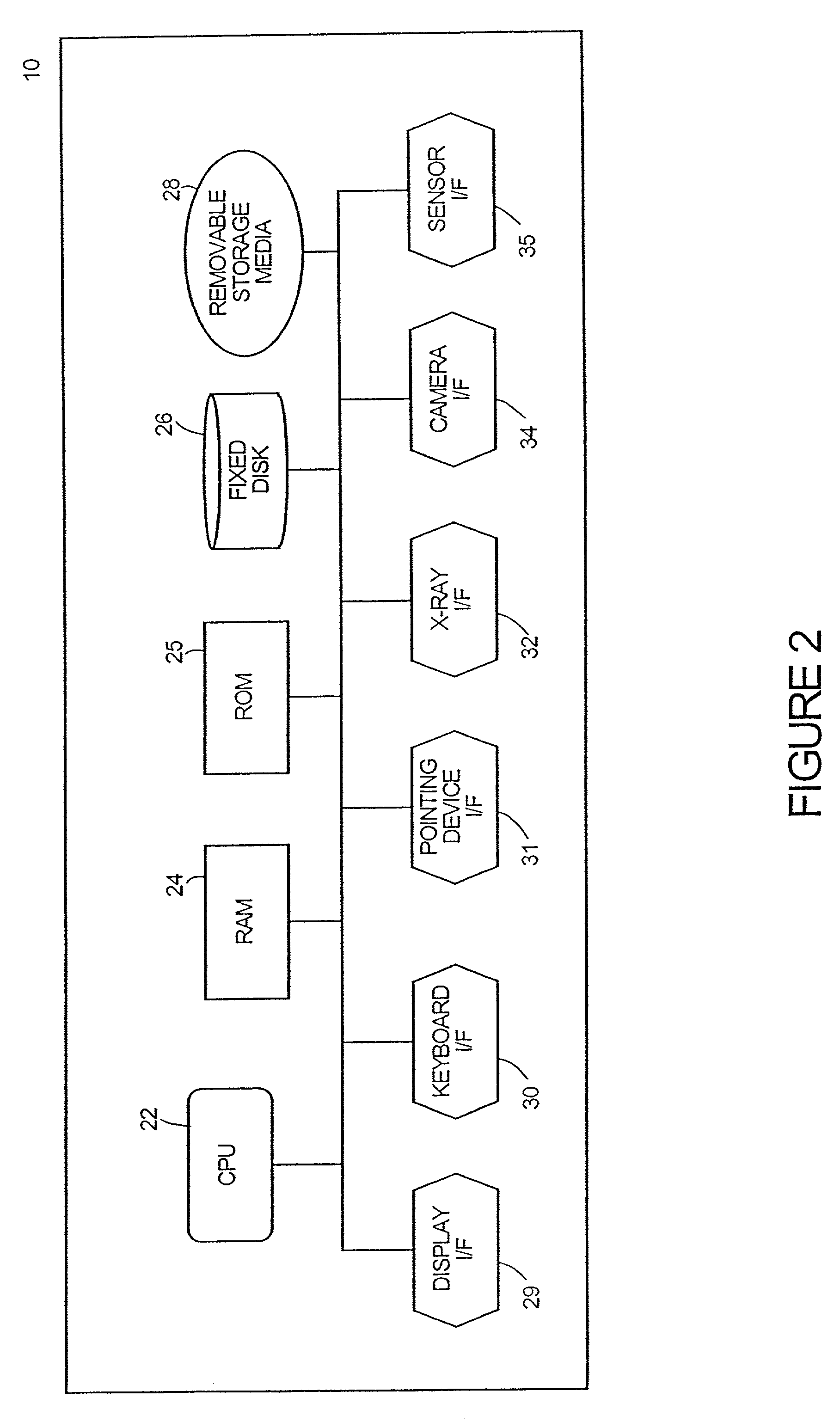Optical recovery of radiographic geometry
a radiographic geometry and optical recovery technology, applied in the field of radiographic imaging, can solve the problems of preventing the use of these systems, obtaining or maintaining the geometry, and inaccuracy of the generated three-dimensional radiographic information, and achieve the effect of facilitating procedures
- Summary
- Abstract
- Description
- Claims
- Application Information
AI Technical Summary
Benefits of technology
Problems solved by technology
Method used
Image
Examples
first embodiment
[0040]FIG. 5 depicts representative positioning of the radiographic system according to the invention. In order to generate three-dimensional radiographic information from two-dimensional radiographic images, the two-dimensional radiographic images are acquired from different positions relative to subject 19. In this embodiment, imaging head 15, together with x-ray source 16 and cameras 17 and 18, are moved along a direction indicated by arrow A while irradiating subject 19 from different positions along arrow A. For example, from a first position at 43a to a second position (shown in phantom lines) at 43b. Arrow A is a direction parallel to sensor 20, thereby keeping the distance between x-ray source 16, and therefore also cameras 17 and 18, and sensor 20 constant for each of the different positions. Additionally, in this embodiment subject 19 is in a fixed position relative to sensor 20 and therefore the only element changing positions during the acquisition of radiographic images...
second embodiment
[0074]Radiographic and visible light images are acquired of subject 19 according to the process described above with reference to the flowchart depicted in FIG. 4. In addition to positioning imaging head 15, together with x-ray source 16 and cameras 17 and 18, in step S402, sensor 20 is also positioned in step S402 in the manner described above with reference to FIG. 9. Once the desired images have been acquired, the radiographic images and visible light images are processed according to the procedure described above with reference to FIG. 6. Variations in the procedure are described below.
[0075]FIG. 10 is a representative example of the system geometry in the second embodiment of the invention with respect to cameras 17 and 18 and subject 19. For purposes of explanation, some of the elements of the radiographic system have been excluded from FIG. 10. In the second embodiment, imaging head 15 is moved through an arc indicated by arrow AA. Cameras 17 and 18, which move together with...
third embodiment
[0085]Unlike the first two embodiments, the distance between imaging head 15 and sensor 20 is not constant during the process of obtaining the radiographic images. Accordingly, the relative positions of imaging head 15 and sensor 20 must be obtained for each position of imaging head 15. As discussed above, the relative position of sensor 20 can be derived using the visible light images and identifying a reference point on sensor 20. Using the procedures discussed above with respect to determining the relative positions of subject 19 and x-ray source 16, the relative position of sensor 20 is obtained. However, in the process discussed above, the process of determining the relative position of sensor 20 only used a single reference point on sensor 20. In the third embodiment, since imaging head 15 partially rotates around the position of sensor 20, as depicted in FIG. 11, the plane in which sensor 20 lies with respect to x-ray source 16 is recovered in order to determine the relative ...
PUM
 Login to View More
Login to View More Abstract
Description
Claims
Application Information
 Login to View More
Login to View More - R&D
- Intellectual Property
- Life Sciences
- Materials
- Tech Scout
- Unparalleled Data Quality
- Higher Quality Content
- 60% Fewer Hallucinations
Browse by: Latest US Patents, China's latest patents, Technical Efficacy Thesaurus, Application Domain, Technology Topic, Popular Technical Reports.
© 2025 PatSnap. All rights reserved.Legal|Privacy policy|Modern Slavery Act Transparency Statement|Sitemap|About US| Contact US: help@patsnap.com



